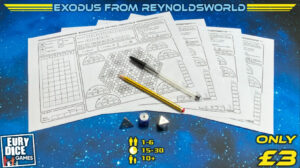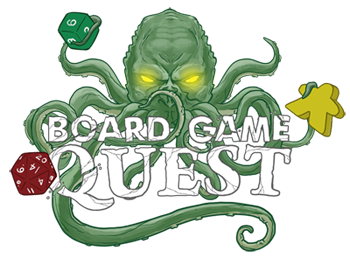 The alien armada is on its way. It’s up to you to get people and supplies moved to a safe location before the planet is invaded or destroyed. No pressure or anything.
The alien armada is on its way. It’s up to you to get people and supplies moved to a safe location before the planet is invaded or destroyed. No pressure or anything.
Exodus from Reynoldsworld is a print at home roll n’ write that tasks you with first building a ship and then using it to transport colonists and supplies away from imminent destruction.
I explored by my first printable roll n’ writes this winter while on a two week business trip. Over a foot of snow fell in my first couple of days leaving me effectively trapped in my vacation rental instead of exploring the environs as I had planned. Those games kept me sane. So I have developed a bit of a soft spot for roll n’ writes, even better when I can print them at home an hour before I leave for the airport.
Will Exodus enter my collection as a must-have in case of stranding? Let’s see.
Gameplay Overview:
The game requires the printed board (of course) and writing implements, one d4 and one d6. For solo gamers like myself add in a d8. Once you have all that, you’re ready to go.
The game is played over ten rounds. Your first step is to build your ship. You can build 10 parts per round and take as many rounds to build your ship as you like. You stock your ship with colonists and supplies, then launch. Your speed is determined by the round in which your ship is launched. The later you launch, the slower you move (speed = number of spaces).

Ships require engines and fuel—these need to be at the base of the ship and are pre-marked on the ship grid. You also need cargo holds for people and supplies. Reactors can provide a speed boost, and finally, you can add ice shields. The ice shields protect you from damage.
At the start of each travel round, you roll one d6 and mark a strike from a micro-meteorite against your ship in the indicated column. Each ice shield can take two hits before it fails. Anything that is not a shield is immediately destroyed.
You travel through a hex grid map from the central planet (Reynoldsworld) to any of the six safe planets. There are three types of hexes: white hexes, which do no damage to the ship, gray hexes, which add one strike from micro-meteorites, and darker gray hexes, which add additional micro-meteorite damage per hex you travel. Once you arrive at the planet, you deliver goods and colonists and calculate the earned points.
If you are the first ship to arrive, you gain a first colony bonus determined by the round in which you landed (earlier in the game is a higher bonus). You also gain points for goods and colonists. These values are determined using d4 and d6 rolls during setup. Yes, there is math. Nothing that can’t be done in your head, though.
You can return to Reynoldsworld for more supplies and colonists, but you cannot repair your ship. At the end of 10 rounds, calculate your scores, highest wins.

Game Impressions:
This is based on solo play only.
Solo rules add one d8 die rolled at the beginning of rounds 2 and 10 to block first colony points on a planet. Otherwise, no rule changes. There is a score chart in the rules to help gauge how well or poorly you did. I like these, and the ones in Exodus have just the right note of droll humor to make even poor scores amusing. For example, one reads, “you saved some people, they thanked you.” If you do really well, they name their planets after you.

The game plays smoothly and pretty quickly once you’ve parsed the rules. There were a few sections in the rules that I had to read a few times before I fully grasped them. Most of them were clarified when I actually started playing.
I am apparently a bit of a conservative player, choosing not to overload reactors every move to boost my speed and trying to plot the least damaging path. Which means overall, I don’t do well. Playing conservatively, don’t expect to visit more than two planets. Getting aggressive, you should be able to visit more. Knowing the first colonist bonuses at the start helps you plan which planets to visit to earn the most points. And it really all comes down to points. Roll for damage, move, math, and repeat.
Final Thoughts:
This game has a simplified pick-up and deliver theme that appeals to me in a genre I have a special fondness for. It’s a solid game, and I think they have structured it well. The only real head scratcher is rolling a d8 in round 10. I think this second roll should be earlier to add tension.
It’s a good game, I have no complaints with the mechanism or the game structure. Something about this just didn’t land with me. It could be that some of the aspects that add challenge, like round = speed, and overloading a reactor to move further, feel like they are really just forcing you into rash decisions that you will pay the price for later. Especially since you can’t repair your ship.
It’s a solid game. There is nothing in this game that I think has been done poorly, it just doesn’t give me that ‘I can do better, one more game’ feeling. Probably this one will stay home next time I travel.
If you are interested in checking out Exodus from Reynoldsworld, it’s in funding now on Gamefound. Head over to the campaign page for more info, or to become a backer.






















